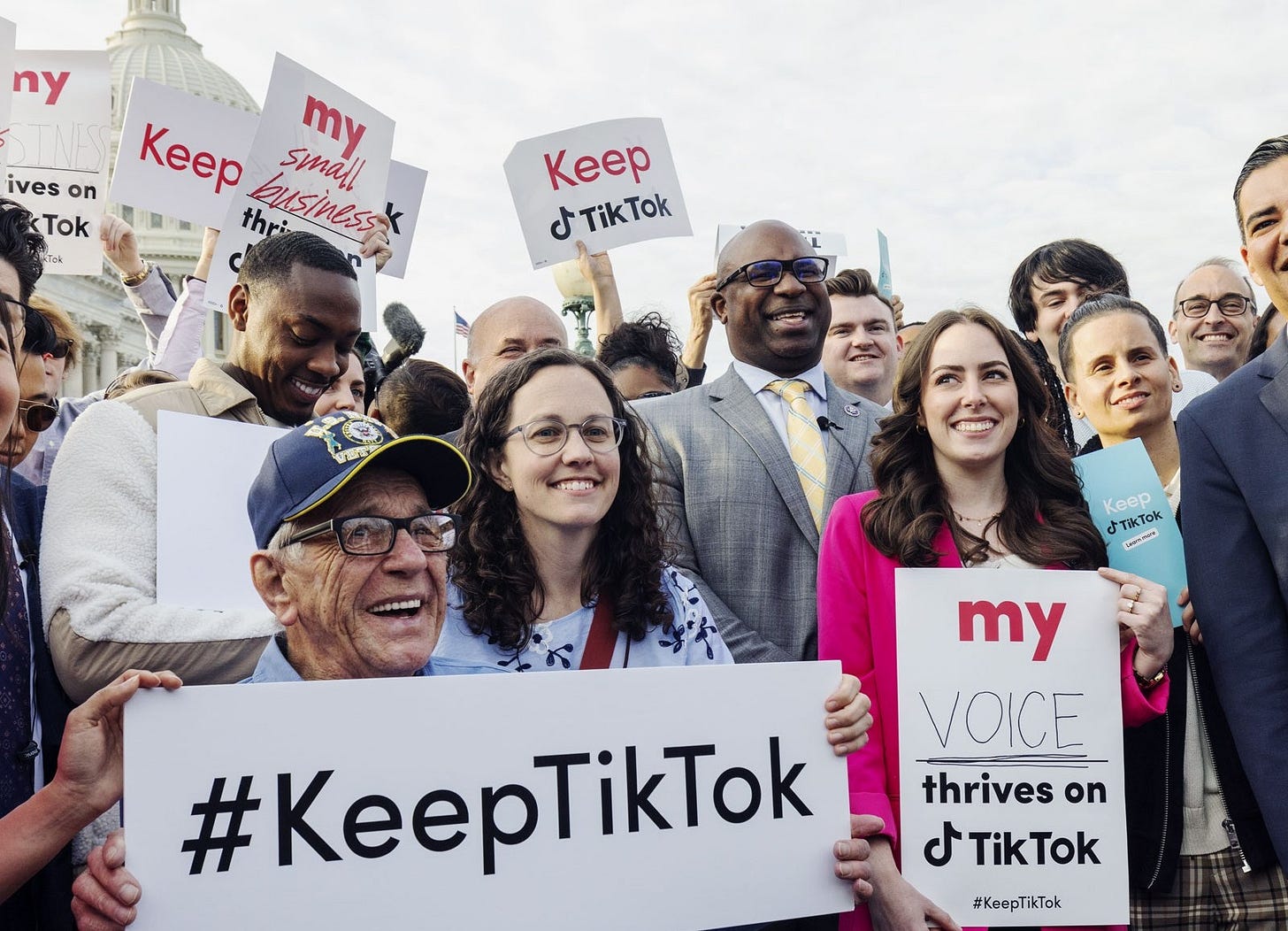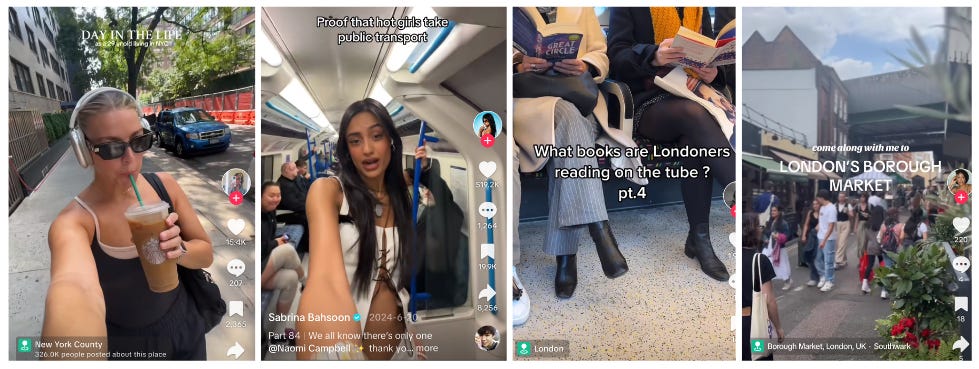Built Different: How TikTok is Changing Our Experience of Cities
POV: living in fear of your favourite hidden gem going viral
Of all social media apps, TikTok has arguably been the most transformative for society (in my opinion as a 2000 baby). Anyone who’s ever had the (un)fortunate pleasure of entering a conversation with me about the impact of technology on society will know that I’m equally fascinated by, and afraid of, how social media is influencing our behaviours and how we relate to one another - both in the digital realm and the “real” world.
As the TikTok ban in America dominates headlines, it’s been interesting to see the various reactions and opinions emerging. While I’m not qualified enough to provide any in-depth socio-political analysis of the ban’s implications, as an active user of social media and a wanna-be anthropologist, I wanted to share my musings about TikTok’s impact on social behaviours and culture. As a built environment nerd, I’ve been particularly interested in exploring what this means for cities and places.
TikTok has always stood out to me for many reasons:
The democratisation of content creation and ease of virality
TikTok is quite literally built different. Unlike Instagram, where content reach is largely restricted to your followers, anyone anywhere in the world can post content that can potentially reach millions of global users on TikTok - if the algorithm works in their favour. By prioritising interest signals over social connections, TikTok has lowered barriers to information, visibility, and earning potential. But like everything internet-related, it's a double-edged sword. While this democratisation feels empowering, it demands more critical consumption from audiences, especially in an age of AI-generated content and rising mis/disinformation.
It might just be the ultimate super app
TikTok is not like the other girls 💅🏾 You can do almost anything on the app these days. Looking for a new pair of trousers or a Cloud Shaped Raindrop Aroma Diffuser? TikTok Shop has got you covered (#TikTokMadeMeBuyIt). Job hunting? The corporate girlies are there for you with their CV/interview tips and day-in-the-life videos. Planning a holiday? Skip Google and head over to the clock app for the ultimate city guide (more on this later).
TikTok as a digital microcosm of society
The platform has evolved into its own digital ecosystem, complete with distinct subcultures (#BookTok, #CottageCore), social hierarchies (influencers vs regular users), and even its own language that spills into real-world conversations (my personal favourite: “I was today years old when I learned…”). Like any society, TikTok has its trends, politics and ever-evolving social dynamics. What I’ve found most fascinating is how these digital behaviours and cultural norms don't just stay contained within the app - they seep into our everyday lives and physical spaces.
Which brings us to what I really want to talk about: how digital culture is re-shaping the way we experience cities.
I’m well aware this is a very complex topic which could easily form the basis of a PhD thesis. So in this piece, I focus on two key ways I think social media is shaping urban experiences, drawing on my observations as a Londoner.
1 - Content Creation in Public Spaces: The Public-Private Paradox
The rise of content creation on platforms like TikTok has turned many public spaces into stages for digital content, which creates interesting dynamics in terms of how different people experience cities. While public spaces have always been public, it’s fair to argue that social media has fundamentally changed what it means to exist comfortably in these spaces. Whether it’s restaurants, public transport, or iconic landmarks, any location can become the backdrop for content creation, with everyone else in that space becoming involuntary background characters. I’ve experienced this first hand on the Tube after a long day at work, standing behind two girls filming a ‘Tube Girl’ style lip-syncing video. For days after, I lived in fear of being immortalised as a grumpy Londoner in the background of a viral TikTok.
Another interesting observation has been how this behaviour affects businesses and service providers in cities - especially small businesses that have grown because of digital marketing and user-generated content. I’ve noticed a few online posts or physical signs in-store where businesses ask customers not to film their staff’s faces without permission. The responses to these boundaries have been mixed. While some people argue that businesses should be grateful for the free publicity and increased sales that come with (viral) social media content, others recognise the deeper issue around consent and the right to privacy.
This trend raises broader questions about how freely we can exist in public spaces without the fear that any moment or action could become content. Yes, these are public spaces, but there’s a difference between being seen by passing strangers and potentially being viewed by millions online. Another question emerges: how do we balance the freedom to film content in public spaces (especially given content creation is now a well-paying job for many people) with everyone else’s right to privacy and comfort?
2 - TikTok Famous Places: Transforming Hidden Gems into Viral Destinations
In recent years, there has been a growing trend of certain attractions, restaurants, public spaces, and even entire cities becoming ‘TikTok famous’, often resulting in high interest from local residents and visitors alike. This has been an interesting trend to observe because it can bring many benefits (and pressures) for both businesses and cities. In London, it’s becoming increasingly common for long-standing, unassuming establishments to suddenly go viral after content creators make videos about their experience there. Trusting the recommendations, their followers are influenced to try it for themselves. This trend has led to a growing call to ‘gatekeep’ certain places, to avoid the overwhelming TikTok popularity that might compromise the experience for locals.
This phenomenon of TikTok fame highlights how digital media and culture can shape our perception and use/exploration of urban spaces. For example, a local restaurant becoming TikTok famous could mean that long-time local customers struggle to simply walk in for dinner, and must book weeks in advance because of the surge in visitors coming from outside the locality or wider city. The ‘right to the city’ debate - who gets to access, use, and shape urban spaces - comes to mind as I consider this, but I think I’ll save that for the PhD thesis 😉
Back to my earlier point about TikTok being the place to go for travel recommendations — there are millions of ‘10 things to do in [insert city here]’ that many people use to shape their perception of a city before they’ve visited, or to determine how they will interact with the places and spaces within that city. This can have its pros and cons given the democratised nature of content creation on platforms like TikTok, whereby people are free to express their realities (but also to amplify false realities).
So what does this mean for cities?
In some ways, the widespread accessibility and use of social media tips the balance of power in terms of who gets the tools and opportunities to shape narratives that inform our collective understanding of a place. The growth and impact of platforms like TikTok gives us plenty of reason to trust that these stories and their telling can have tangible impacts for people and places, though the effects may vary in scope and permanence. In a growing attention economy, a compelling 15-second video of a small town can generate more interest and completely change how that town is discovered, understood, and experienced. The democratisation of place representation we’re witnessing could also create interesting dynamics between major cities and secondary cities, fundamentally challenging traditional urban hierarchies and place marketing strategies.





It’s certainly a fine line between positive outcomes (underrepresented cities in media being shown in a new, engaging light) and the not so positive (small businesses being overwhelmed by influencers, subcultures being driven out of spaces that were once safe for them). Lots of food for thought!
Well done Fola! Great read. It made me think of the ‘city equivalent’ of Joe Lycetts attempt to make a viral takeaway restaurant from a skip. The amplifying false narratives.
The last point is one I haven’t thought of before, why shouldn’t other places such as second cities have their chance at fame and the benefits that brings to local people?Would it in turn make more traditional cities sit up and take notice? Digital playing its part in changing the way we think of, and interact with, cities and places for sure. The good or bad impact debate lingers on, now centred around an app even I'm too old to say I truly understand!